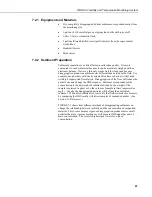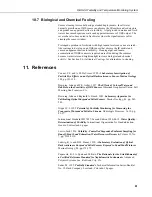
OBS-3A Turbidity and Temperature Monitoring System
10.4 Sediment Color
Sediment color, after particle size, has a major effect on OBS sensitivity, and if
it changes, it can degrade the accuracy of measurements. Although OBS
sensors are “color blind”, “whiteness”, color, and IR reflectivity (measured by
an OBS sensor) are well correlated. Calcite, which is highly reflective and
white in color, will produce a much stronger OBS signal on a mass-
concentration basis than magnetite, which is black and IR absorbing.
Sensitivity to colored silt particles varies from a low of about one for dark
sediment to a high of about ten for light gray sediment; see FIGURE 10-4. In
areas where sediment color is changing with time, a single calibration curve
may not work. Resulting errors will depend on the relative concentrations of
colored sediments.
0
2
4
6
8
Munsell Value (Black = 0)
10
0.0
0.2
0.4
0.6
0.8
1.0
Infrared Reflectan
ce
Calcite
Bytownite
Actinolite
Magnetite
FIGURE 10-4. IR reflectance of minerals
10.5 Water Color
Several OBS users have been concerned that color from dissolved substances
in water samples (not colored particles discussed in the previous section)
produces erroneously low turbidity measurements. Although organic and
inorganic IR-absorbing dissolved matter has visible color, its effect on OBS
measurements is small unless the colored compounds are strongly absorbing at
the OBS wavelength (875 nm) and are present in very high concentrations.
Only effluents from mine-tailings appear to produce enough color to absorb
measurable IR. In river, estuary, and ocean environments concentrations of
colored materials are too low by at least a factor of ten to produce significant
errors.
59




















